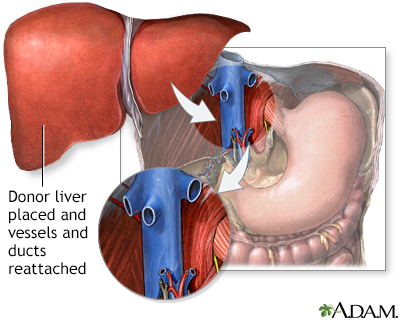Pregnancy SmartSiteTM
Hepatic transplant; Transplant - liver; Orthotopic liver transplant; Liver failure - liver transplant; Cirrhosis - liver transplant DefinitionLiver transplant is surgery to replace a diseased liver with a healthy liver. DescriptionThe donated liver may be from:
The donor liver is transported in a cooled salt-water (saline) solution that preserves the organ for up to 8 hours. The necessary tests can then be done to match the donor with the recipient. The new liver is removed from the donor through a surgical cut in the upper abdomen. It is placed into the person who needs the liver (called the recipient) and attached to the blood vessels and bile ducts. The operation may take up to 12 hours. The recipient will often need a large amount of blood through a transfusion. Why the Procedure Is PerformedA healthy liver performs more than 400 jobs each day, including:
The most common reason for a liver transplant in children is biliary atresia. In most of these cases, the transplant is from a living donor. The most common reason for a liver transplant in adults is cirrhosis. Cirrhosis is scarring of the liver that prevents the liver from working well. It can worsen to liver failure. The most common causes of cirrhosis are:
Other illnesses that may cause cirrhosis and liver failure include:
Liver transplant surgery is often not recommended for people who have:
RisksRisks of any anesthesia are:
Risks of any surgery are:
Liver transplant surgery and management after surgery carry major risks. There is an increased risk for infection because you must take medicines that suppress the immune system to prevent transplant rejection. Signs of infection include:
Before the ProcedureYour health care provider will refer you to a transplant center. The transplant team will want to make sure that you are a good candidate for a liver transplant. You will make a few visits over several weeks or months. You will need to have blood drawn and x-rays taken. If you are the person getting the new liver, the following tests will be done before the procedure:
You may choose to look at one or more transplant centers to determine which is best for you.
If the transplant team thinks you are a good candidate for a liver transplant, you will be put on a national waiting list.
While you are waiting for a liver, follow these steps:
After the ProcedureIf you received a donated liver, you will likely need to stay in the hospital for a week or longer. After that, you will need to be closely followed up by a doctor for the rest of your life. You will have regular blood tests after the transplant. The recovery period is about 6 to 12 months. Your transplant team may ask you to stay close to the hospital for the first 3 months. You will need to have regular check-ups, with blood tests and x-rays for many years. Outlook (Prognosis)People who receive a liver transplant may reject the new organ. This means that their immune system sees the new liver as a foreign substance and tries to destroy it. To avoid rejection, almost all transplant recipients must take medicines that suppress their immune response for the rest of their lives. This is called immunosuppressive therapy. Although the treatment helps prevent organ rejection, it also puts people at a higher risk for infection and cancer. If you take immunosuppressive medicine, you need to be regularly screened for cancer. The medicines may also cause high blood pressure and high cholesterol, and increase the risks for diabetes. A successful transplant requires close follow-up with your provider. You must always take your medicine as directed. ReferencesCarrion AF, Martin P. Liver transplantation. In: Feldman M, Friedman LS, Brandt LJ, eds. Sleisenger and Fordtran's Gastrointestinal and Liver Disease. 11th ed. Philadelphia, PA: Elsevier; 2021:chap 97. Everson GT. Hepatic failure and liver transplantation In: Goldman L, Schafer AI, eds. Goldman-Cecil Medicine. 26th ed. Philadelphia, PA: Elsevier; 2020:chap 145. | |
| |
Review Date: 5/4/2022 Reviewed By: Michael M. Phillips, MD, Emeritus Professor of Medicine, The George Washington University School of Medicine, Washington, DC. Also reviewed by David C. Dugdale, MD, Medical Director, Brenda Conaway, Editorial Director, and the A.D.A.M. Editorial team. The information provided herein should not be used during any medical emergency or for the diagnosis or treatment of any medical condition. A licensed medical professional should be consulted for diagnosis and treatment of any and all medical conditions. Links to other sites are provided for information only -- they do not constitute endorsements of those other sites. No warranty of any kind, either expressed or implied, is made as to the accuracy, reliability, timeliness, or correctness of any translations made by a third-party service of the information provided herein into any other language. © 1997- A.D.A.M., a business unit of Ebix, Inc. Any duplication or distribution of the information contained herein is strictly prohibited. | |

 Donor liver attach...
Donor liver attach...
